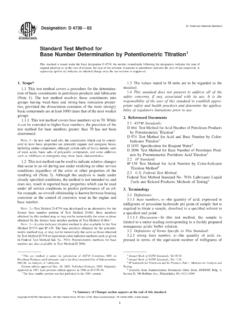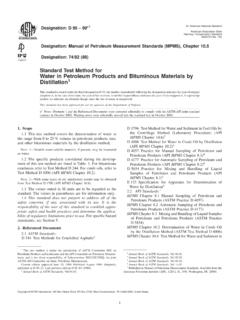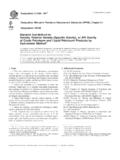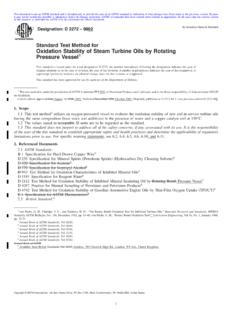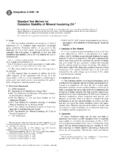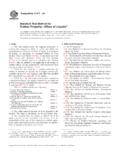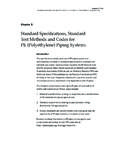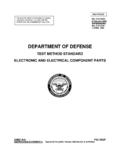Transcription of Standard Test Method for Acid Number of …
1 Designation: D 664 04 Designation 177/96An American National StandardBritish Standard 4457 Standard Test Method forAcid Number of petroleum Products by PotentiometricTitration1 This Standard is issued under the fixed designation D 664; the Number immediately following the designation indicates the year oforiginal adoption or, in the case of revision, the year of last revision. A Number in parentheses indicates the year of last reapproval. Asuperscript epsilon (e) indicates an editorial change since the last revision or Standard has been approved for use by agencies of the Department of Scope* This test Method covers procedures for the determina-tion of acidic constituents in petroleum products and lubricantssoluble or nearly soluble in mixtures of toluene and propan-2-ol. It is applicable for the determination of acids whosedissociation constants in water are larger than 10-9; extremelyweak acids whose dissociation constants are smaller than 10-9do not interfere.
2 Salts react if their hydrolysis constants arelarger than 10-9. The range of acid numbers included in theprecision statement is mg/g KOH to 150 mg/g In new and used oils, the constituents that may be consideredto have acidic characteristics include organic and inorganic acids, esters,phenolic compounds, lactones, resins, salts of heavy metals, salts ofammonia and other weak bases, acid salts of polybasic acids, and additionagents such as inhibitors and The test Method may be used to indicate relativechanges that occur in oil during use under oxidizing conditionsregardless of the color or other properties of the resulting the titration is made under definite equilibriumconditions, the test Method is not intended to measure anabsolute acidic property that can be used to predict perfor-mance of oil under service conditions.
3 No general relationshipbetween bearing corrosion and acid Number is The acid Number obtained by this Standard may or may not benumerically the same as that obtained in accordance with Test MethodsD 974 and D 3339. There has not been any attempt to correlate thismethod with other non-titration The values stated in SI units are to be regarded as thestandard. The values given in parentheses are for Standard does not purport to address all of thesafety concerns, if any, associated with its use. It is theresponsibility of the user of this Standard to establish appro-priate safety and health practices and determine the applica-bility of regulatory limitations prior to standards :D 974 Test Method for Acid and Base Number by Color-Indicator TitrationD 1193 Specification for Reagent WaterD 3339 Test Method for Acid Number of petroleum Prod-ucts by Semi-Micro Color Indicator TitrationD 4057 Practice for Manual Sampling of petroleum andPetroleum ProductsD 4177 Practice for Automatic Sampling of petroleum andPetroleum Products3.
4 Number ,n the quantity of base, expressed asmilligrams of potassium hydroxide per gram of sample, re-quired to titrate a sample in a specified solvent to a specifiedend This test Method expresses the quantityof base as milligrams of potassium hydroxide per gram ofsample, that is required to titrate a sample in a mixture oftoluene and propan-2-ol to which a small amount of water hasbeen added from its initial meter reading in millivolts to ameter reading in millivolts corresponding to an aqueous basicbuffer solution or a well-defined inflection point as specified inthe test This test Method provides additionalinformation. The quantity of base, expressed as milligrams of1 This test Method is under the jurisdiction of ASTM Committee D02 onPetroleum Products and Lubricants and is the direct responsibility of on Analysis of edition approved Feb.
5 1, 2004. Published March 2004. Originallyapproved in 1942. Last previous edition approved in 2001 as D 664 test Method was adopted as a joint ASTM-IP Standard in 1964. ASTM TestMethod D 4739 has been developed as an alternative to the base Number portion ofD referenced ASTM standards , visit the ASTM website, , orcontact ASTM Customer Service at ForAnnual Book of ASTMS tandardsvolume information, refer to the Standard s Document Summary page onthe ASTM *A Summary of Changes section appears at the end of this ASTM International, 100 Barr Harbor Drive, PO Box C700, West Conshohocken, PA 19428-2959, United hydroxide per gram of sample, required to titrate asample in the solvent from its initial meter reading in millivoltsto a meter reading in millivolts corresponding to a freshlyprepared aqueous acidic buffer solution or a well-definedinflection point as specified in the test Method shall be reportedas thestrong acid The causes and effects of the so-calledstrong acids and the causes and effects of the other acids can bevery significantly different.
6 Therefore, the user of this testmethod shall differentiate and report the two, when they Summary of Test The sample is dissolved in a mixture of toluene andpropan-2-ol containing a small amount of water and titratedpotentiometrically with alcoholic potassium hydroxide using aglass indicating electrode and a reference electrode or acombination electrode. The meter readings are plotted manu-ally or automatically against the respective volumes of titratingsolution and the end points are taken only at well-definedinflections in the resulting curve. When no definite inflectionsare obtained and for used oils, end points are taken at meterreadings corresponding to those found for aqueous acidic andbasic buffer Significance and New and used petroleum products may contain acidicconstituents that are present as additives or as degradationproducts formed during service, such as oxidation relative amount of these materials can be determined bytitrating with bases.
7 The acid Number is a measure of thisamount of acidic substance in the oil, always under theconditions of the test. The acid Number is used as a guide in thequality control of lubricating oil formulations. It is alsosometimes used as a measure of lubricant degradation inservice. Any condemning limits must be empirically Since a variety of oxidation products contribute to theacid Number and the organic acids vary widely in corrosionproperties, the test Method cannot be used to predict corrosive-ness of oil under service conditions. No general correlation isknown between acid Number and the corrosive tendency of oilstoward Titration , a voltmeter or a potentiometer that will operatewith an accuracy V and a sensitivity Vover a range of at V when the meter is used with theelectrodes specified in and and when the resistancebetween the electrodes falls within the range from to 20MV.
8 The meter shall be protected from stray electrostatic fieldsso that no permanent change in the meter readings over theentire operating range is produced by touching, with agrounded lead, any part of the exposed surface of the glasselectrode, the glass electrode lead, the titration stand, or A suitable apparatus could consist of a continuous-readingelectronic voltmeter designed to operate on an input of less than 5310 12A, when an electrode system having 1000-MVresistance is connectedacross the meter terminals and provided with a metal shield connected tothe ground, as well as a satisfactory terminal to connect the shieldedconnection wire from the glass electrode to the meter without interferencefrom any external electrostatic Electrode, Standard pH, suitable for non-aqueous Electrode, Silver/Silver Chloride (Ag/AgCl) Reference Electrode, filled with 1M 3M LiCl in Electrodes Sensing electrodes mayhave the Ag/AgCl reference electrode built into the sameelectrode body, which offers the convenience of working withand maintaining only one electrode.
9 The combination electrodeshall have a sleeve junction on the reference compartment andshall use an inert ethanol electrolyte, for example, 1M 3 MLiCl in ethanol. These combination electrodes shall have thesame response or better response than a dual electrode shall have removable sleeves for easy rinsing andaddition of A third electrode, such as a platinum electrode, may be usedto increase the electrode stability in certain Mechanical Stirrer, a suitable type,equipped with a propeller-type stirring paddle. The rate ofstirring shall be sufficient to produce vigorous agitation withoutspattering and without stirring air into the solution. A propellerwith blades 6 mm in radius and set at a pitch of 30 to 45 issatisfactory. A magnetic stirrer is also If an electrical stirring apparatus is used, it shall beelectrically correct and grounded so that connecting or discon-necting the power to the motor will not produce a permanentchange in the meter reading during the course of the , 10-mL capacity, graduated in divi-sions and calibrated with an accuracy mL.
10 Theburette shall have a tip that extends 100 to 130 mm beyond thestopcock and shall be able to deliver titrant directly into thetitration vessel without exposure to the surrounding air orvapors. The burette for KOH shall have a guard tube containingsoda lime or other CO2-absorbing Beaker, 250 mL capacity, made of borosili-cate glass or other suitable Stand, suitable for supporting the electrodes,stirrer, and An arrangement that allows the removal of the beaker withoutdisturbing the electrodes and stirrer is Titration Automatic titration systems shall be able to carry outthe necessary analyses as prescribed in the Method . As aminimum, the automatic titration system shall meet the perfor-mance and specification requirements listed in as A dynamic mode of titrant addition shall be the titration, the speed and volume of the addition shallvary depending on the rate of change of the system.
